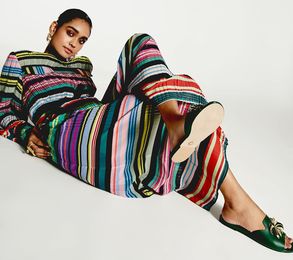The last thing the luxury business needed was the winner of the best actress award at the Oscars to go up to receive her statuette and say, “I think my dress is broken.” Emma Stone’s sartorial snafu was caused by none other than the mega brand she was wearing, Louis Vuitton.
The wardrobe malfunction has come on the most glamorous night of the modern world—the Oscars. Its red carpet is also where the liaison between fashion and films began, when Giorgio Armani famously dressed Richard Gere for American Gigolo. But luxury labels are witnessing a slowdown in sales. After the post-pandemic boom, where the allure of glamour outweighed all common sense, with people aching to dress up and go out, shoppers have pulled back. It is ironic as the US economy is on a healthy footing; Bloomberg has reported the GDP forecast for 2024 at double of what it was last year.
Businessoffashion.com says there is a renewed focus on ready-to-wear as customers have overdosed on couture and handbags. The Prada group’s results echo this, showing an 82 per cent rise in sales at their RTW label, Miu Miu.
Interestingly, the label that is probably the hardest hit is Gucci; its sales are down by four per cent. Gucci, once the biggest driver of the Kering group (it accounts for more than half of Kering’s revenues), is now its biggest liability. The new Gucci, under Sabato De Sarno, appears to be inspired by ready-to-wear, but with the price tag of couture. Its advertising and coordinated covers on Elle and Vogue magazines (this month’s Vogue India has Tripti Dimri wearing Gucci) have not created much impact. Moreover, it signed on movie star Alia Bhatt last year to anchor itself to its growing Asian audience, but Bhatt is not known for her sartorial savoir faire, unlike Louis Vuitton’s Deepika Padukone.
India’s ready-to-wear market is growing. The new generation of Indian fashion designers are staying away from bridal wear and designing clothes they would like to wear themselves. They are finding an audience that is younger and chicer. They may not be big spenders, but they are repeat clients, which bridal wear nearly rules out. Ready-to-wear fashion can also allow for multiple and regular purchases, instead of that one-time massive sale.
Designer ready-to-wear is usually priced between Rs10,000 and Rs30,000.
Dhruv Kapoor, who makes men’s as well as women’s western wear, has been showing at Milan Fashion Week for a few seasons now. Moonray, the new ready-to-wear offering from Chanakya, has two stores in as many years already. Pero, a stylish and whimsical label by Aneeth Arora, has swept much of Europe and Japan since its inception. It has finally begun to showcase at fashion weeks in India, hoping for a bigger slice of the RTW pie. Anamika Khanna launched a more accessible line, AK-OK, two years ago.
Couture giant Rahul Mishra relaunched his ready-to-wear collection at Paris fashion week six months ago, signalling his plans to take it global. Mishra’s new label is called ‘A Few Rahul Mishra’, and is the result of a joint venture with Reliance Brands. He had launched RTW in 2006 when he made his debut, but it was not as well received as it is today. Two months ago, a multi-brand store ordered 300 pieces from ‘A Few...’ and placed a re-order two weeks ago.
The bridal purchases are still taking place at the designer’s flagships. But multi-brand outlets like Ogaan and Ensemble are thriving with RTW sales, opening newer stores in cities like Kolkata and Ahmedabad respectively. Indian ready-to-wear is a small space ready to go big.


